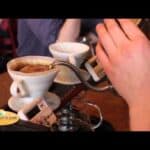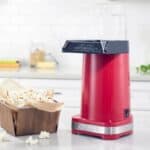Often, making delicious pour over coffee is more effort than it’s worth. You have to pour water a certain way, and it all seems a little woo-woo. Except that it is worth it so much.
There is just something special about brewing your own coffee. To get to that point, you need to master the water pouring technique. When talking about the water pouring process, it’s easy to fall into pseudoscience and guesswork, but there is actually a decent amount of hard science that can be used to develop an understanding of how the technique works. Another worthwhile experience.
Here are some benefits of the method…
- The taste and extraction will be more balanced
- Richer, cleaner flavors
- By using bad technique (or no technique at all), your coffee will likely end up imbalanced, either too bitter or too sour. This isn’t how you drink coffee.
Why Pour Over Coffee Even Requires A Technique
During immersion brewing, the coffee grounds and water sit together for a couple of minutes, resulting in a fairly straightforward extraction. Pouring over coffee is different because the water is constantly draining.
The always-draining design constantly replenishes the brewed coffee with fresh, clean water as it drains. In addition to speeding up the process and producing a cleaner-tasting coffee, the process creates a problem that’s almost certain to arise.
If the water is not channeled properly, it will create channels through the grounds. The water will always choose the path of least resistance when draining. When a path is paved through the grounds, the water will most likely follow it, thanks to our friend Gravity.
The grounds along these channels will experience over-extraction, whereas the grounds in more dry areas of the coffee bed will not receive sufficient extraction. Due to this, the brew is both bitter and sour. Because of this, you can’t just fill a dripper with water and let it drain on its own. Natural channels are created by it.
There’s only one solution: saturate all the grounds with water. What is the best way to accomplish this? Over the coffee bed, pour a slow, steady stream of water in circles.
This requires some specific steps, so let’s take a look at them.
Tools Needed To Master The Pouring Technique
With an average kettle, the exact amount of water that needs to be poured is not possible. I strongly recommend investing in a gooseneck kettle (specifically designed for pour over coffee).
Kettles with long, thin pouring spouts slow down the flow of water and give you complete control over the speed and placement of your pour. If you don’t have a gooseneck kettle, you’ll have to use a large spouted kettle that can’t pour smoothly or consistently. With this kind of brewing, consistency is key.
The second piece of equipment that makes this technique easier to master is a coffee scale. It will work with any kitchen scale that can read grams without much delay.
You can see in real time how much water you have poured and how fast it’s coming out when you use a scale. Without a scale, you’re just guessing, which leaves a lot of room for error.
Get a pour over kettle if you could only choose one.
Mastering Your Pour Over Coffee Pouring Technique
We’re now going to examine the specific technique that experienced coffee brewers use when making pour over coffee. In this case, we’ll start with blooming.
The Bloom
The initial contact of the coffee and water initiates a variety of physical and chemical changes in the grounds that prepare them for brewing, so it’s imperative that you hit all the grounds. CO2 gas is released rapidly here, which is a big event. Since the gas is coming out so powerfully, the ground won’t be able to absorb water very quickly, so we even have this stage.
Pour twice as much water as there is coffee in grams. If you’re using 20g of coffee, pour in 40g (or 40ml, same thing) of water. Pour very slowly in controlled circles. Make your way from the center to the edges, hitting all the grounds evenly. Now you wait for about 20-30 seconds.
The Main Pouring
After the bloom phase is complete, you can start pouring again. The following points should be kept in mind.
Circular, slow movements. Pour slowly in circles starting in the center. Make sure to move throughout the grounds to keep them saturated.
The deepest part of the coffee bed is in the center. While doing slow circles, you should pour more in the middle than on the sides because there are more grounds in the center (because of the cone shape).
Make sure you don’t hit the sides. The water that hits the sides of the brewer is more likely to run down the wall of the filter rather than actually going through the coffee. When this happens, it is difficult to control extraction, so avoid it.
Don’t let your arm drift. When you sling the kettle around, one side of the coffee bed will be hit with more water than the other. When moving gently, the water falls on top of the coffee instead of driving into it.
Scales should be observed to identify patterns. Once you’ve done a few pours and have a sense of how the process is progressing, look for repeatable milestones. Put 150g in by the 1:30 mark, for example. If you need to slow down or speed up, you can use that checkpoint to determine your progress.
The Final Moments
The last 15 seconds of your pour should be in the center of the bed of coffee. The cone shape means that there is actually more coffee in the middle than on the sides.
However, you will not pour in the center for the last 1-2 seconds. The next step is known as ‘ rinsing the sides ‘.
You should direct the stream as little as possible to the sides of the filter and give the coffee clinging there a quick rinse. As the water drains, this allows stuck grounds to loosen and sink to the bottom.
The reason for doing this is to avoid riding on high and dry ground. As the water drains, these are the sediments that stick to the filter sides and don’t remain saturated. Consequently, less is extracted from these grounds than from the rest, resulting in an imbalance. By rinsing the sides, all the grounds drain and brew evenly. If you are looking for best pour over coffee maker recommendation, we have a list for you.
Was this helpful?
Hi there! I’m a food enthusiast and journalist, and I have a real passion for food that goes beyond the kitchen. I love my dream job and I’m lucky enough to be able to share my knowledge with readers of several large media outlets. My specialty is writing engaging food-related content, and I take pride in being able to connect with my audience. I’m known for my creativity in the kitchen, and I’m confident that I can be the perfect guide for anyone looking to take their culinary journey to the next level.








